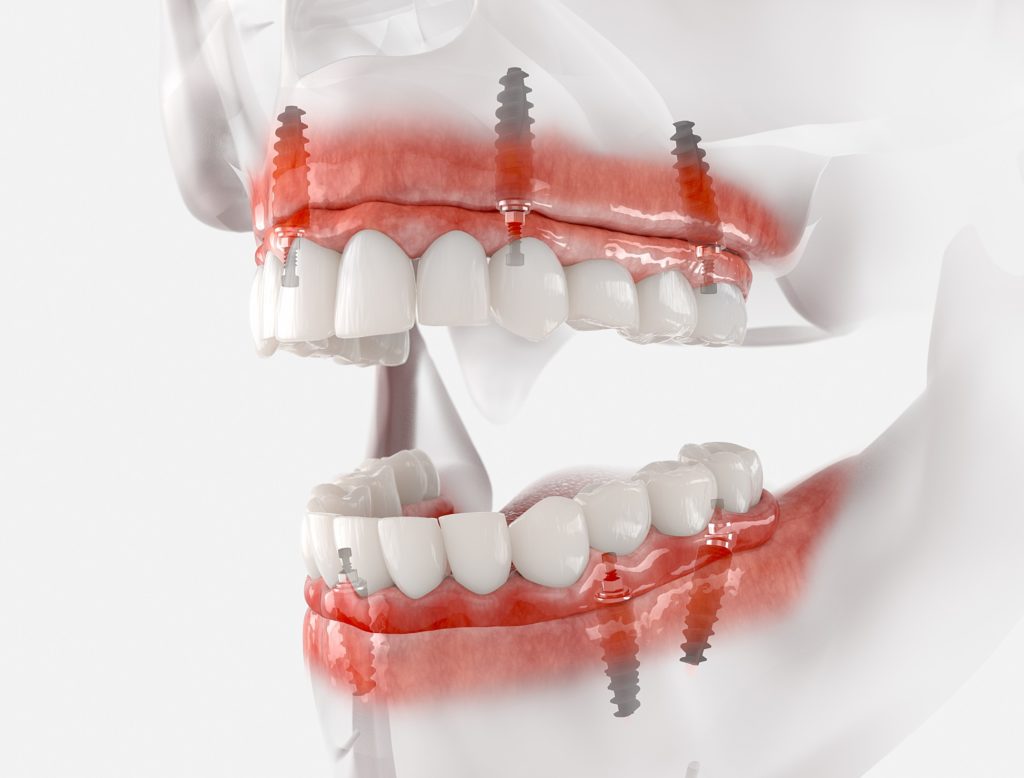Implanty stomatologiczne są sztucznymi zębami o takim samym kształcie jak nasze zęby
naturalne. Implanty dentystyczne poprawiają wygląd jamy ustnej, pomagają nabrać
pewności siebie i cieszyć się codziennymi czynnościami.
W kości szczęki umieszcza się śrubę, która łączy się z naturalną kością. Zapewnia to mocną
podstawę dla implantów. Implanty dentystyczne są stosowane z powodzeniem od prawie 30
lat. Są to najsilniejsze dostępne narzędzia do podtrzymywania zębów zastępczych.
Plusy zdecydowania się na implanty zębów:
- Implanty dentystyczne wyglądają i funkcjonują się jak nasze naturalne zęby
- Poprawiają wygląd jamy ustnej
- Łączą się z kością i są trwałe
- Zapewniają pełen komfort
- Implanty dentystyczne pomagają przeżuwać jedzenie bez bólu związanego z podrażnieniem reszty zębów i dziąseł
- Pomagają przywrócić długotrwały stan zdrowia jamy ustnej
Współczesna stomatologia oferuje wiele rozwiązań implantologicoznych umożliwiających
odbudowę pełnego łuku zębowego. Różnicujemy je ze względu na typ konstrukcji,
zastosowany materiał oraz sposób zakładania. Implanty standardowe idealnie sprawdzą się
w zastąpieniu pojedynczych ubytków w uzębieniu. Implanty zygomatyczne stosuje się w
przypadku rozległych i sporych ubytków w uzębieniu, a nawet w przypadkach deficytu lub
zaniku kości szczęki.
Stosuje się kilka metod odbudowy kości w przypadku, gdy kość szczęki nie jest w stanie
utrzymać implantów dentystycznych. Ważne jest, by zachować naturalną linię żuchwy,
która zapewni mocną podstawę dla implantów. Augmentacja kości to technika, która służy
do odbudowy lub regeneracji kości szczęki, w przypadku, gdy nie ma możliwości
utrzymania implantu. Podniesienie dna zatoki szczękowej, to technika nazywana Sinus Lift
i jest ona przygotowaniem do leczenia implatologicznego dla pacjentów z nisko położonym
dnem zatoki. Proces polega na wytworzeniu nowej kości poprzez spłycenie zatoki
szczękowej. zabieg ten umożliwi prawidłowe wprowadzenie implantów. Ridge expansion to
technika, gdzie chirurg musi przygotować przestrzeń pomiędzy podzielnymi odcinkami
kości, by móc póżniej wypełnić ją wykonując przeszczep kostny.
Obecnie możliwe jest uzupełnienie brakujących lub uszkodzonych zębów w ciągu 72
godzin – skontaktuj się z nami, a my skontaktujemy Cię z najlepszym chirurgiem
stomatologiem.

An implant is a replacement for the root or roots of a tooth. They are used to secure crowns to the jawbone using titanium and titanium alloy. These metals are used because they are lightweight and biocompatible – which means they aren’t rejected by the body. Dental implants are used to replace teeth due to decay, disease, oral cancer, or many other causes.

Types of dental implants
Endosteal: dental implants are made of titanium and shaped like small screws. These dental implants are established in the jaw bone.
Subperiosteal: This type of dental implant is established under the gum, on or above the jawbone. It may be a good choice for someone with an inadequate natural jawbone or for someone who does not wish to go for a bone augmentation treatment to rebuild it.
Zygomatic: It is a complicated procedure and is only used when a person doesn't have enough jawbone for the endosteal implant. This type of implant is done in the patient's cheekbone rather than the jawbone.
Procedure
Several methods are used to rebuild bone in case your jawbone cannot support dental implants. These techniques retain your natural jawline and give a strong foundation for implant-supported teeth. These include:
1. Bone augmentation: This technique is used for restoring or regenerating bone in your jaw when it cannot support the implant.
2. Sinus Lift: In this technique, bone is added below the sinus in cases where the natural bone has deteriorated because of missing upper back teeth. It is called sinus augmentation or sinus upliftment.
3. Ridge expansion: In this procedure, the ridge bone is detached, and the inner and outer segments of the bone are wedged apart. This is to prepare a space between the divided sections of bone that can be filled with bone graft.
2. Sinus Lift: In this technique, bone is added below the sinus in cases where the natural bone has deteriorated because of missing upper back teeth. It is called sinus augmentation or sinus upliftment.
3. Ridge expansion: In this procedure, the ridge bone is detached, and the inner and outer segments of the bone are wedged apart. This is to prepare a space between the divided sections of bone that can be filled with bone graft.
The 3D Imaging and treatment planning technique helps to save time and money and also reduces recovery time. This helps analyse the jaw’s anatomy and determine the best place for the implant. It is now also possible to get a replacement for your missing or damaged teeth in 72 hours – contact us, and we will refer you to the best available dental surgeon.
